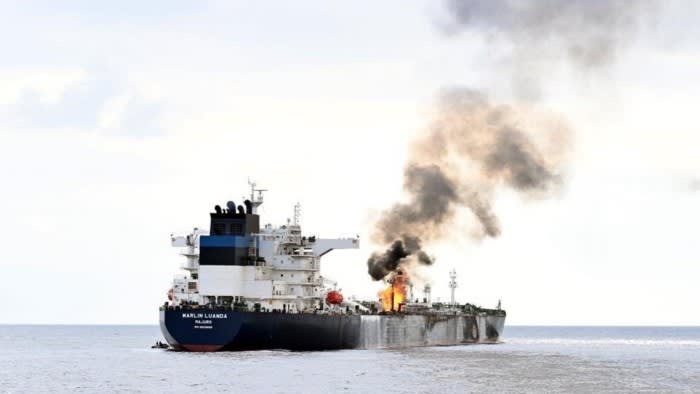
Unlock the Editor’s Digest for free
Roula Khalaf, Editor of the FT, selects her favourite stories in this weekly newsletter.
The latest Houthi attack — on a vessel working for commodities trader Trafigura in the Gulf of Aden — has pushed up fuel tanker rates and diesel prices, with shipping executives and oil market analysts forecasting further rises in both.
Freight rates have already jumped to levels not previously experienced outside a brief spike at the height of the Covid-19 pandemic. Charter prices for the largest tankers used for oil products — such as diesel, petrol and jet fuel — have more than doubled in the past week to $101,500, according to figures from Gibson, a London shipbroker. Figures in November averaged just $22,750 a day.
Many oil product tankers had started to take the longer route around the Cape of Good Hope rather than going through the dangerous Red Sea after the Marlin Luanda, a tanker carrying the refined oil product, was attacked last Friday.
Jacob Meldgaard, chief executive of Torm, a Copenhagen-based operator of 80 oil product tankers, said that Cape diversions would tighten the market, adding 5 per cent to worldwide demand for product tankers. The increase was “very material” at a time when utilisation of the fleet was very high, he said.
A diversion via the Cape increases the length of a voyage from the Gulf to northern Europe by about 70 per cent compared with going via Suez.
The attack also pushed up global diesel prices to a near three-month high as traders fear higher costs and supply disruptions of crucial supplies from Asia to Europe.
Gasoil futures, the global benchmark, have risen 15 per cent from mid-December, to $845 a metric tonne, reflecting investors’ growing concerns that Europe will be squeezed by supply chain issues in coming months.
The region is one of the world’s largest purchasers of refined petroleum products, and has relied on imports from Asia and the US in the past year after the EU banned the use of Russian diesel in the bloc. Refinery maintenance in the US would further cut supplies across the Atlantic and drive up diesel prices, analysts warned.
In the shipping market, the Red Sea crisis will continue to add volatility. One senior shipping executive said the Red Sea crisis would push up freight rates, as long as demand for oil products remained at present levels. Only a handful of new product tankers are due for delivery this year, meaning vessel supply will not increase.
Analysts and shipping executives also expect further diversions to boost the currently modest rates for crude oil tankers.
While crude tankers are chartered weeks or months before voyages, the longer distances undertaken will push up rates; Suezmaxes, which carry 1mn barrels of oil and are the largest kind able to use the canal fully laden, are expected to be particular beneficiaries.
Alexander Saverys, chief executive of crude oil operator Euronav, said that further diversions were likely to push up rates for the largest tankers. Euronav is not currently sailing via Suez.
“As was showcased very clearly again on Friday, shipowners that transit through the area put the lives of their seafarers at risk,” he said, referring to the Marlin Luanda attack. “We believe more vessels will avoid the area.”
